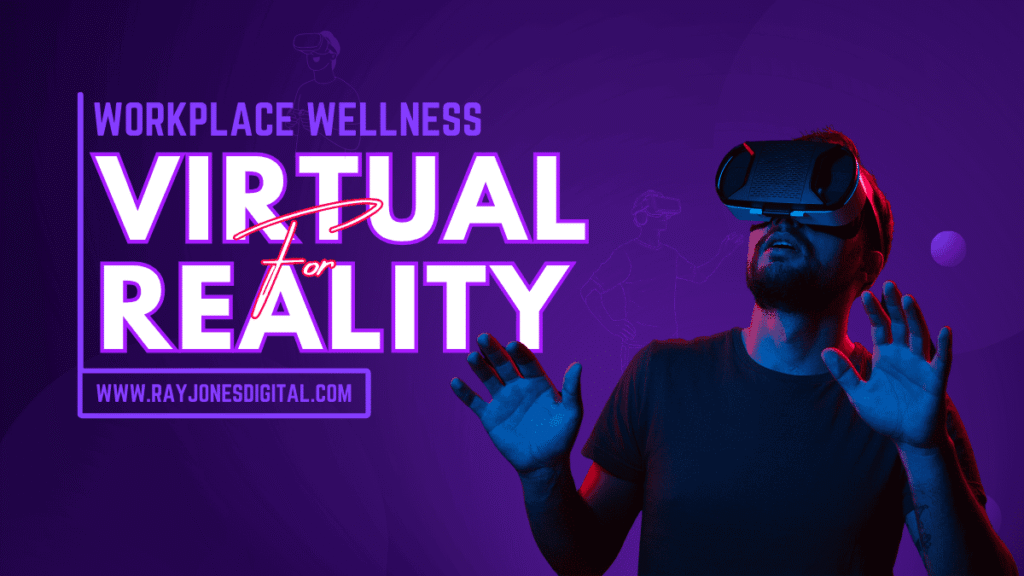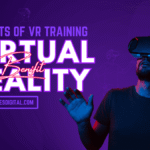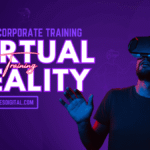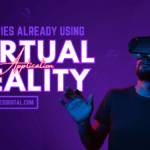
Employee wellbeing has become a critical business priority, with 76% of workers reporting burnout affects their job performance. Traditional wellness programmes gym memberships, meditation apps, and lunch-and-learn sessions often fail to engage employees meaningfully or address the root causes of workplace stress. VR for Workplace.
Virtual reality is transforming how organisations approach employee wellness, offering immersive experiences that reduce stress, improve mental health, and create lasting behavioural changes. This comprehensive guide explores how VR technology is revolutionising workplace wellness programmes and why forward-thinking companies are investing in these innovative solutions.
The Science Behind VR Wellness Solutions
Virtual reality wellness applications work by leveraging the brain’s natural response to immersive environments. When users enter virtual spaces, their nervous systems react as if experiencing real situations, triggering genuine physiological and psychological responses that promote wellbeing.
Neurological Impact of VR Relaxation
VR meditation and relaxation experiences activate the parasympathetic nervous system, which controls the body’s rest-and-digest response. Research published in the Journal of Medical Internet Research demonstrates that VR meditation sessions reduce cortisol levels by 23% more effectively than traditional meditation practices.
The technology creates what neuroscientists call “presence”—a feeling of being physically located in the virtual environment. This presence triggers the same neural pathways activated during actual relaxation experiences, such as walking through nature or practising yoga in peaceful settings.
Brain imaging studies reveal that VR wellness experiences increase activity in the prefrontal cortex, the brain region responsible for emotional regulation and stress management. This enhanced brain activity translates to improved mood, reduced anxiety, and better stress resilience.
Physiological Benefits of Virtual Environments
VR wellness programmes produce measurable physiological improvements that extend beyond the virtual experience. Heart rate variability studies show that employees using VR relaxation applications demonstrate improved cardiovascular health markers within four weeks of regular use.
The technology also influences breathing patterns and muscle tension. Guided VR breathing exercises teach proper diaphragmatic breathing techniques whilst providing real-time biofeedback through heart rate monitoring and breathing pattern analysis.
Sleep quality improvements represent another significant benefit. Employees who participate in VR wellness programmes report 34% better sleep quality, with reduced sleep latency and fewer nighttime awakenings.
Stress Reduction Through Immersive Experiences
VR’s ability to transport users to calming environments provides immediate stress relief that traditional wellness methods cannot match. Virtual nature experiences, in particular, demonstrate remarkable stress-reduction capabilities.
Virtual Nature Therapy
Forest bathing, or shinrin-yoku, has proven stress-reduction benefits, but urban employees rarely have access to natural environments during work hours. VR nature experiences replicate these benefits by immersing users in realistic forest, beach, or mountain environments.
Research indicates that five-minute VR nature experiences reduce perceived stress levels by 27% and improve mood scores by 32%. These improvements persist for several hours after the virtual experience ends, providing sustained stress relief throughout the workday.
The technology enables personalised nature experiences tailored to individual preferences. Some employees find ocean sounds most relaxing, whilst others prefer forest environments or mountain vistas. VR platforms can customise experiences based on user preferences and stress levels.
Mindfulness and Meditation Applications
VR meditation applications provide structured mindfulness training that helps employees develop long-term stress management skills. These programmes guide users through breathing exercises, body scans, and mindfulness techniques within immersive virtual environments.
The visual and auditory elements of VR meditation create stronger focus and engagement than traditional meditation apps. Users report finding it easier to maintain concentration and achieve deeper meditative states within virtual environments.
Progressive muscle relaxation programmes use VR to teach tension-release techniques whilst providing visual feedback about muscle relaxation. This combination of instruction and biofeedback accelerates skill development and improves technique accuracy.
Mental Health Support and Intervention
VR wellness programmes extend beyond stress reduction to provide comprehensive mental health support, including anxiety management, depression prevention, and emotional regulation training.
Anxiety Management and Exposure Therapy
VR exposure therapy helps employees overcome workplace-related anxieties in safe, controlled environments. Public speaking anxiety, meeting participation fears, and performance anxiety can all be addressed through gradual exposure to virtual scenarios.
The technology allows for systematic desensitisation, where users gradually increase their exposure to anxiety-provoking situations. This approach builds confidence and reduces anxiety responses over time.
Social anxiety programmes use VR to create virtual networking events, team meetings, and presentation scenarios. Employees can practice social interactions and develop confidence without real-world consequences.
Depression Prevention and Mood Enhancement
VR wellness programmes incorporate mood enhancement activities that combat depression and improve overall mental wellbeing. Virtual experiences designed to trigger positive emotions, such as virtual travel or creative activities, help maintain positive mental states.
Cognitive behavioural therapy (CBT) techniques are integrated into VR programmes to help employees identify and change negative thought patterns. Interactive virtual scenarios allow users to practice CBT strategies in realistic workplace situations.
The technology also provides virtual social connection opportunities for remote workers who may experience isolation. Virtual coffee breaks, team building activities, and collaborative spaces help maintain social bonds and prevent loneliness.
Physical Wellness Integration
VR wellness programmes extend beyond mental health to encompass physical wellness, offering innovative solutions for exercise, posture improvement, and injury prevention.
Virtual Fitness and Movement
VR fitness applications make exercise more engaging and accessible within workplace environments. Virtual boxing, yoga, and dance programmes provide effective workouts without requiring extensive equipment or dedicated fitness spaces.
The gamification elements of VR fitness improve motivation and adherence rates. Employees can track progress, compete with colleagues, and unlock achievements that encourage continued participation.
Micro-fitness sessions designed for office environments help employees incorporate movement into their workday. Five-minute virtual yoga breaks or stretching routines can be completed at desks without changing clothes or disrupting workflow.
Posture Training and Ergonomics
VR posture training programmes use motion tracking to monitor employee posture and provide real-time feedback about positioning. These systems identify poor posture habits and guide users through corrective exercises.
Virtual ergonomics training teaches proper desk setup, monitor positioning, and keyboard technique through interactive simulations. Employees can practice proper ergonomic principles before implementing changes in their actual workspaces.
The technology provides ongoing posture monitoring throughout the workday, sending gentle reminders to adjust position or take movement breaks. This continuous feedback helps develop better postural habits over time.
Employee Engagement and Programme Adoption
VR wellness programmes achieve higher engagement rates than traditional wellness initiatives because they provide novel, enjoyable experiences that employees actually want to use.
Gamification and Motivation
VR wellness applications incorporate game elements that make healthy behaviours more engaging and rewarding. Progress tracking, achievement systems, and social challenges encourage continued participation and healthy competition.
Virtual reward systems allow employees to earn points, badges, or virtual items for completing wellness activities. These rewards create positive reinforcement that encourages regular programme participation.
Team challenges and group activities foster social support and accountability. Employees can form virtual wellness groups, share progress, and support each other’s wellness goals through collaborative VR experiences.
Personalisation and Customisation
VR wellness programmes adapt to individual preferences, fitness levels, and wellness goals. Personalised experiences increase engagement by ensuring that activities are relevant and appropriately challenging for each user.
Adaptive algorithms monitor user behaviour and adjust programme difficulty and content recommendations accordingly. This personalisation ensures that employees remain engaged and challenged without becoming overwhelmed.
The technology also accommodates different learning styles and preferences. Visual learners benefit from immersive environments, whilst kinesthetic learners engage with interactive movement-based activities.
Measuring VR Wellness Programme Success
Effective VR wellness programmes require comprehensive measurement strategies that track both immediate outcomes and long-term behavioural changes.
Biometric and Health Indicators
VR wellness platforms can integrate with wearable devices to monitor physiological indicators such as heart rate, sleep patterns, and stress levels. This data provides objective evidence of programme effectiveness.
Regular health assessments track changes in blood pressure, body mass index, and other health markers that may improve through VR wellness participation. These measurements demonstrate the physical health benefits of virtual wellness interventions.
Mental health screening tools assess changes in anxiety, depression, and stress levels over time. Regular surveys and psychological assessments provide quantitative evidence of programme impact on employee wellbeing.
Productivity and Performance Metrics
VR wellness programmes often correlate with improved workplace productivity and performance. Metrics such as absenteeism rates, sick leave usage, and performance reviews can indicate programme effectiveness.
Employee satisfaction surveys measure changes in job satisfaction, work-life balance, and overall wellbeing. These subjective measures complement objective health data to provide comprehensive programme evaluation.
Healthcare cost analysis examines whether VR wellness programmes reduce medical expenses and insurance claims. Decreased healthcare utilisation may indicate improved employee health and reduced stress-related medical issues.
Implementation Strategies for VR Wellness
Successful VR wellness programme implementation requires careful planning, appropriate technology selection, and comprehensive change management strategies.
Technology Infrastructure and Equipment
VR wellness programmes require reliable technology infrastructure to deliver consistent, high-quality experiences. Network capacity, processing power, and display quality all impact user experience and programme effectiveness.
Equipment selection should consider factors such as comfort, hygiene, and ease of use. Lightweight headsets with easy cleaning protocols are essential for workplace deployment where multiple users share equipment.
Cloud-based VR platforms reduce hardware requirements and enable remote access for distributed teams. These solutions provide scalability and reduce IT maintenance requirements whilst delivering high-quality experiences.
Training and Support Systems
Employee training programmes should address both VR technology usage and wellness programme participation. Clear instructions, hands-on training, and ongoing support ensure successful adoption and engagement.
Wellness champions within the organisation can provide peer support and encourage programme participation. These advocates help create positive programme culture and address employee concerns about VR technology.
Technical support systems must be available to address equipment issues, software problems, and user questions. Responsive support maintains programme momentum and prevents technical difficulties from disrupting participation.
Privacy and Data Security
VR wellness programmes collect sensitive health and biometric data that requires robust privacy protection and security measures. Data encryption, secure storage, and limited access protocols protect employee information.
Clear privacy policies should explain what data is collected, how it’s used, and who has access to information. Transparency about data handling builds trust and encourages programme participation.
Compliance with healthcare privacy regulations, such as HIPAA, ensures that VR wellness programmes meet legal requirements for health information protection.
Return on Investment and Cost-Benefit Analysis
VR wellness programmes require significant initial investment but provide substantial returns through improved employee health, reduced healthcare costs, and increased productivity.
Healthcare Cost Reduction
Companies implementing VR wellness programmes report 15-25% reduction in healthcare costs within the first year. These savings result from reduced stress-related medical visits, improved mental health, and better chronic disease management.
Preventive health benefits of VR wellness programmes reduce the likelihood of expensive medical interventions. Early stress management and mental health support prevent more serious conditions that require costly treatment.
Workers’ compensation claims related to stress and repetitive strain injuries decrease when employees participate in VR wellness programmes. The preventive nature of these interventions reduces workplace injury risks.

I am Ray Jones Digital
My current occupations: a Digital Marketer, Local SEO expert, Link Builder, and WordPress SEO specialist. Shopify SEO, Ecommerce Store Management, and HTML & WordPress Developer I have been practicing the above mentioned services for more than 10 years now As an SEO expert working with your ongoing projects.



